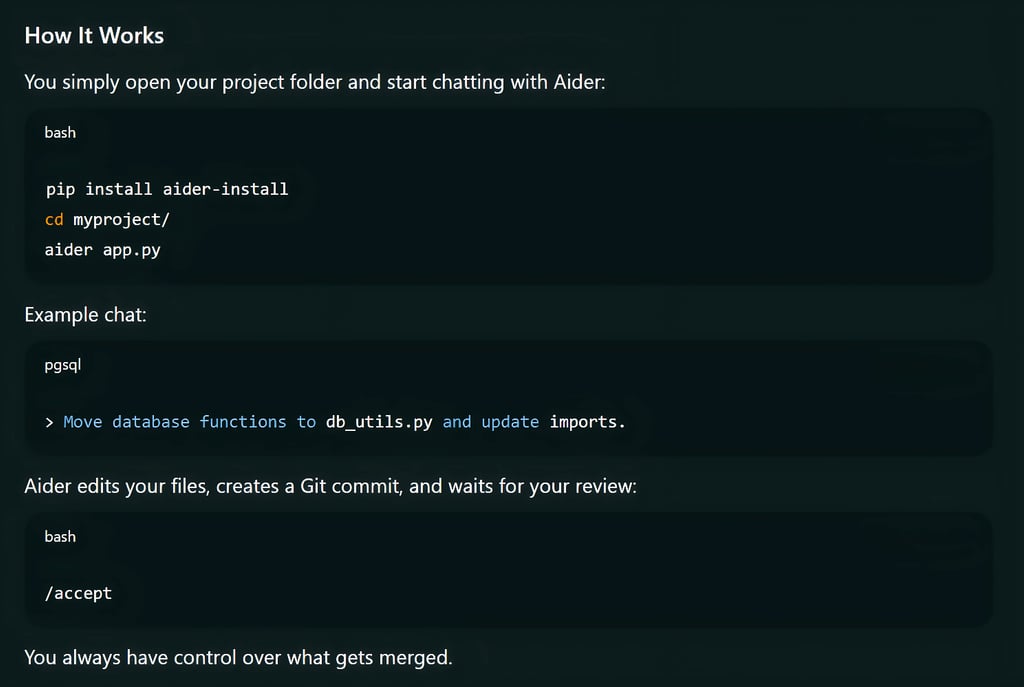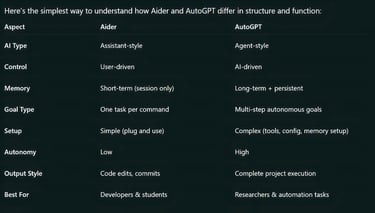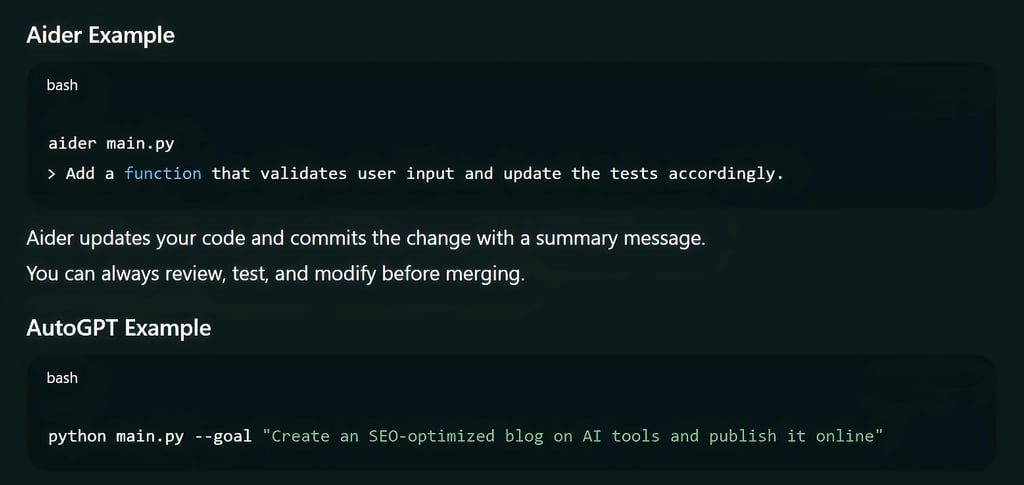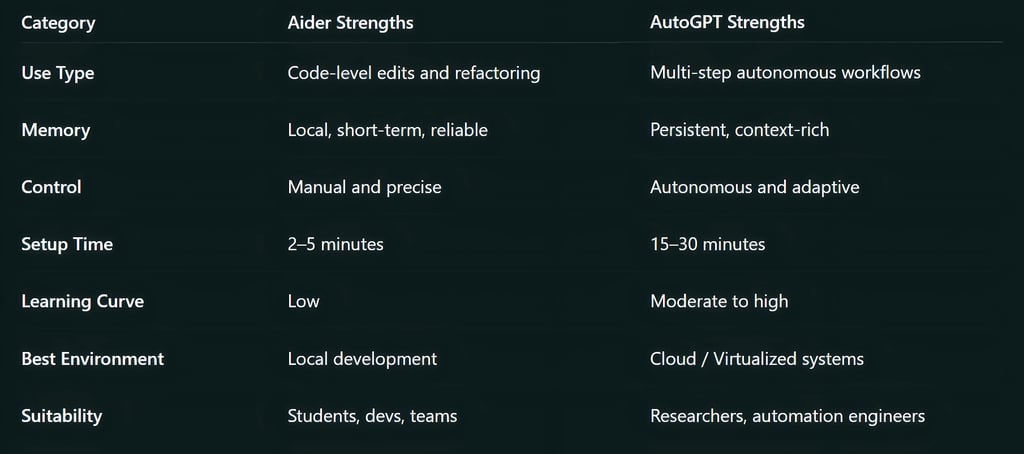
Aider vs AutoGPT: Understanding the Difference Between AI Coding Assistant and Agent-Style AI
Aider vs AutoGPT explores the evolving landscape of AI-powered coding and automation. This in-depth comparison breaks down how Aider acts as a human-centered coding assistant while AutoGPT functions as an autonomous agent with memory and self-directed workflows. Learn their features, differences, architecture, use cases, and how they fit into modern developer and creative environments.
AI ASSISTANTEDITOR/TOOLSAI/FUTURECOMPANY/INDUSTRY
Sachin K Chaurasiya
11/19/202510 min read


Artificial Intelligence is changing how we code, create, and automate. Two standout tools in this field are Aider and AutoGPT. They both use large language models (LLMs), but their purpose and design are very different one focuses on helping humans write code efficiently, while the other works as an independent AI agent capable of planning and acting on its own.
Let’s explore both tools in detail.
What is Aider?
Aider is an AI-powered coding assistant that integrates directly with your local development environment and Git repository. It works like an AI pair programmer, helping you write, refactor, and improve code all while keeping your workflow transparent and under your control.
Key Features
Runs inside your terminal or IDE (no external dashboards).
With Git integrated, every edit is committed automatically.
Works with popular LLMs like GPT-4, Claude, and local models.
Supports multiple programming languages.
Lets you approve or reject AI-generated edits easily.
Designed for real-world coding it understands structure, syntax, and context.
When to Use
For developers or students working on coding assignments or projects.
When you want a controlled AI assistant that edits code safely.
When you prefer real-time feedback instead of autonomous decisions.
Perfect for debugging, refactoring, and test creation.
Advantages
✅ Works directly inside your local environment.
✅ Keeps Git commits for every AI-generated change.
✅ Transparent, reliable, and developer-friendly.
✅ Ideal for learning and professional development.
✅ No complex setup or memory management needed.
Limitations
❌ Limited long-term memory.
❌ Needs user instructions for every step.
❌ Cannot plan multi-step goals autonomously.




What is AutoGPT?
AutoGPT is an AI agent, a more independent, goal-oriented system. It doesn’t just follow instructions step by step. Instead, it plans, executes, and evaluates multiple actions automatically to complete a big task. For instance, if you say,
“Research AI web design trends and create a landing page about it.”
AutoGPT can:
Search online for the latest trends.
Generate the content and code.
Build the website.
Deploy it to a hosting service.
Analyze the results.
It acts like an autonomous AI system that uses tools, memory, and reasoning to achieve a goal.
Key Features
Agent-style AI: Thinks, plans, and executes without constant prompts.
Has short-term and long-term memory (using local storage or vector databases).
Can use external tools, APIs, and browsers.
Great for automating multi-step projects.
Useful in research, workflow automation, and data analysis.
When to Use
When you need an AI agent to automate workflows or tasks.
When you’re exploring multi-step or research-heavy projects.
Ideal for business automation, data processing, and creative planning.
When you want your AI to remember context between sessions.
Advantages
✅ Works independently after you define the goal.
✅ Supports long-term memory and context recall.
✅ Can integrate APIs, tools, and the internet.
✅ Handles multi-step tasks automatically.
✅ Ideal for automation, analysis, and creative workflows.
Limitations
❌ Requires more setup and configuration.
❌ Can make unpredictable or irrelevant decisions.
❌ Needs supervision to stay on track.
❌ High token and API costs for long tasks.





Architecture and Working Principles
Aider
Built on a prompt-response architecture, where the user defines changes and the model responds with specific code edits.
It dynamically tracks file dependencies and uses internal prompts to keep the context relevant.
Every time you add a file, Aider creates a context snapshot, helping the AI “see” how different files connect without overloading the model’s token window.
Uses diff-based commits, which ensures minimal risk of breaking the main codebase.
Because it doesn’t depend on continuous internet access, it’s ideal for offline or secured enterprise setups.
AutoGPT
Uses a loop-based architecture; each cycle includes “think → plan → execute → review → repeat.”
Memory is stored using embeddings in a vector database, allowing it to recall information across long tasks.
It can chain multiple LLM calls, where one output feeds the next step (a form of self-prompting).
Some implementations allow tool chaining e.g., AutoGPT can call other APIs, local scripts, or even trigger Aider to code.
It’s modular: developers can customize agent behaviors, tool sets, or memory logic.
Performance and Efficiency
Aider
Works best for medium-sized repositories (a few hundred files).
Performance depends on the LLM token window; larger models like GPT-4-turbo or Claude 3 Opus allow Aider to handle bigger contexts smoothly.
Ideal for iterative coding because each request focuses on one contained change.
Low compute cost it’s lightweight and efficient on local machines.
AutoGPT
Resource-heavy, each loop can trigger multiple API calls, increasing latency and cost.
Task completion time grows with complexity, especially if web access or data retrieval is enabled.
Works best when fine-tuned with clear goals and limited exploration depth to prevent infinite reasoning loops.
Can be optimized with task queues or parallel sub-agents, but that adds engineering overhead.
Integration and Compatibility
Aider
Compatible with Git, GitHub, VS Code, and JetBrains IDEs.
Can run alongside developer tools like pytest, Docker, or Black (for code formatting).
Easy to embed in CI/CD pipelines for instance, you can automate style checks or test generation before pushing commits.
Works offline with local LLMs like Llama 3, Mistral, or Ollama useful for privacy-sensitive environments.
AutoGPT
Can integrate with APIs like Google Search, Notion, Slack, Trello, or custom endpoints.
Supports plugin systems, allowing developers to add specialized tools (e.g., for financial data, analytics, or image processing).
Works with frameworks like LangChain or LlamaIndex to manage memory and reasoning.
Often deployed in Dockerized environments or cloud VMs with persistent storage and logging.
Security and Privacy
Aider
Since it runs locally, your source code never leaves your environment (unless you use a cloud LLM).
Git-based structure provides full version tracking and rollback capabilities.
It never executes arbitrary code without your confirmation, reducing the risk of accidental file modification.
AutoGPT
Because it uses tool access and file I/O, there’s potential for unintended actions if not sandboxed.
Should always be run in a controlled or virtualized environment (Docker recommended).
When using API keys (OpenAI, Bing, etc.), it’s important to restrict permissions and budgets.
Memory stores should be encrypted, especially when handling client or business data.
Educational Value and Learning Impact
Aider
Excellent for students; it helps visualize how code changes affect the project.
Great for understanding refactoring logic, best practices, and test-driven development.
Teaches how to collaborate with AI without losing coding skills, an important concept for modern software engineers.
AutoGPT
A great way to study autonomous agent design and multi-step reasoning.
Useful for students learning AI architecture, memory management, and workflow automation.
Encourages exploration of ethical AI behavior, since autonomy introduces decision-making beyond direct human input.
Limitations in Real-World Scenarios
Aider Limitations (Technical)
Doesn’t yet support continuous memory across separate sessions.
Token limits can restrict very large repositories or monolithic codebases.
LLMs may occasionally misunderstand file structures if too many files are added.
AutoGPT Limitations (Operational)
Can consume large amounts of tokens quickly, increasing API costs.
Risk of getting stuck in recursive reasoning loops without supervision.
Dependent on external APIs for browsing, which can affect reliability.
Still experimental for production use; more stable for R&D environments.


Future Developments (Trend Forecasts)
Aider’s Future
Developers are working on persistent memory modules, allowing Aider to “remember” your coding style or past projects.
Integration with custom LLM fine-tuning is being explored, enabling personalized coding habits.
Possible support for multi-agent collaboration Aider instances communicating across repositories.
AutoGPT’s Future
Moving toward goal-aware intelligent systems that can self-optimize their loops.
Integration with AI memory clouds, allowing shared knowledge across multiple agents.
Expected improvements in context compression (saving reasoning steps efficiently).
More stable, sandboxed runtimes for enterprise safety and cost control.
Real-World Example Scenarios
Scenario 1: A Web Developer’s Daily Workflow
Use Aider to clean up your JavaScript or update UI components.
Then, use AutoGPT to research new UX trends, generate design ideas, and organize your to-do tasks automatically.
Scenario 2: A Student Learning Python
Aider can help you debug assignments, explain errors, and optimize code logic.
AutoGPT can generate study schedules, create topic summaries, or write project documentation.
Scenario 3: A Business Owner
Aider can maintain your product’s source code or handle version updates.
AutoGPT can manage content pipelines from research and blog creation to analytics reporting.
Comparative Perspective with Other AI Tools
Compared to GitHub Copilot, Aider gives more transparency and control through Git commits.
Compared to AgentGPT or BabyAGI, AutoGPT offers deeper memory handling and open modular design.
Aider focuses on micro-level code editing; AutoGPT focuses on macro-level task orchestration.


FAQs
Q: What is the main difference between Aider and AutoGPT?
Aider is a coding assistant it helps you edit, fix, and refactor code under your control.
AutoGPT is an AI agent; it can act autonomously, plan tasks, and execute them without constant guidance. In simple terms: Aider assists, AutoGPT acts.
Q: Is Aider suitable for beginners or students?
Yes. Aider is perfect for beginners and students learning programming. It helps understand how code works by showing clean diffs, clear changes, and explanations. Since every change is committed to Git, you can learn safely without breaking your main codebase.
Q: Can AutoGPT write and deploy code automatically?
Yes, but with limitations. AutoGPT can generate, modify, and deploy code autonomously if it has access to required tools and APIs. However, it may not always produce perfect results; you’ll need to review, test, and adjust its work. It’s best used for multi-step workflows, not precise code editing.
Q: Does Aider have memory like AutoGPT?
Aider uses session memory, meaning it remembers context during the current chat or project session. Once restarted, it doesn’t retain old conversations.
AutoGPT, on the other hand, supports long-term memory through databases (like Pinecone or Chroma) and can recall information across sessions.
Q: Which tool is better for professionals or developers?
For developers, Aider is ideal for:
Writing and debugging code quickly
Keeping version control
Working within real projects
For AI researchers or automation engineers, AutoGPT is better for:
Experimenting with autonomous agents
Automating repetitive workflows
Handling complex multi-step reasoning
Q: Can Aider and AutoGPT work together?
Yes. They can complement each other beautifully.
For example:
AutoGPT can plan a project, break down tasks, and assign coding subtasks.
Aider can then execute those coding tasks safely within Git.
This hybrid setup allows high-level AI planning (AutoGPT) and controlled AI coding (Aider).
Q: Do these tools require an internet connection?
Aider: Works locally and can even use offline LLMs (like Llama 3 or Mistral) for private environments.
AutoGPT: Requires internet access if you want it to browse, fetch data, or interact with APIs.
So, Aider is more suitable for offline or secure enterprise environments, while AutoGPT thrives in connected systems.
Q: How does Aider ensure code safety?
Aider tracks every change via Git commits, so you can:
See exactly what was modified.
Roll back to a previous version anytime.
Prevent unwanted or broken code from being merged.
This makes Aider very safe for professional developers and teams.
Q: How does AutoGPT store and use memory?
AutoGPT stores memory in two ways:
Short-term memory: Keeps the active task context in RAM or cache.
Long-term memory: Saves key details to a vector database for recall later.
This allows AutoGPT to “remember” what it did in earlier runs like goals, research results, or partial outputs.
Q: Can Aider replace GitHub Copilot?
Not entirely; both serve different purposes.
GitHub Copilot predicts and completes code inline while you type.
Aider interacts with your full project, understands structure, and modifies multiple files intelligently.
In short, Aider is more like an AI collaborator, while Copilot is an AI autocomplete tool.
Q: Is AutoGPT safe to use for automation?
It’s safe if configured carefully. Always run AutoGPT in a sandboxed or Docker environment to prevent accidental file deletions or uncontrolled API calls. Also, set strict permissions and cost limits to prevent excessive token usage or unwanted actions.
Q: Which tool is faster to set up and use?
Aider: Installs and runs in minutes with a simple pip install command.
AutoGPT: Takes more time since it requires API setup, memory configuration, and tool integrations.
If you need speed and simplicity, go for Aider.
If you need complex workflow automation, choose AutoGPT.
Q: Can AutoGPT handle real-world projects like website creation?
Yes, but with supervision. AutoGPT can:
Research topics
Generate content
Create code
Deploy websites
However, it still needs human review to ensure accuracy, brand alignment, and quality control.
Q: How do Aider and AutoGPT manage cost efficiency?
Aider: Uses fewer API calls, and the token cost is predictable and low.
AutoGPT: Runs multiple LLM loops per goal, which can quickly increase API costs.
Professionals often use local or open-source models to make AutoGPT cheaper to run.
Q: Are there any open-source alternatives to these tools?
Yes.
Alternatives to Aider: CodeGPT, Continue.dev, Cline, and GitHub Copilot Chat.
Alternatives to AutoGPT: BabyAGI, AgentGPT, SuperAGI, and LangGraph.
However, Aider and AutoGPT remain among the most popular and active open-source options.
Q: Which is better for UI/UX or creative professionals?
Aider helps you code and refine front-end components (HTML, CSS, JS).
AutoGPT can automate content generation, market research, and workflow planning for creative projects.
Together, they make a powerful duo for designers who handle both creative and technical tasks.
Q: Is AutoGPT reliable for long-term projects?
AutoGPT is still experimental. It’s reliable for research and prototype automation but not yet ready for critical production use. Future versions aim to improve stability, goal tracking, and cost optimization.
Q: Can I use Aider without coding experience?
Yes, to an extent. You can ask Aider to:
Explain code logic in plain English.
Simplify complex functions.
Suggest best coding practices.
But basic coding knowledge helps you review its suggestions effectively.
Q: How do both tools handle large projects?
Aider: Efficient for medium-sized codebases; uses selective context to avoid token overload.
AutoGPT: Can manage large projects if memory and task limits are configured properly but performance drops if goals aren’t well-defined.
Q: What’s the future of Aider and AutoGPT?
Both are evolving rapidly:
Aider is working toward persistent memory and style learning, making it remember your preferences.
AutoGPT is improving reasoning loops, cost management, and adaptive goal correction.
Together, they represent the shift from AI-assisted to AI-autonomous development.
Q: Which one should I learn first?
Start with Aider; it teaches you how to collaborate with AI safely and efficiently.
Once you’re comfortable with AI-assisted coding, explore AutoGPT to understand how autonomous agents plan and execute goals.
Q: Can Aider or AutoGPT be customized?
Yes, both are open-source:
You can modify Aider’s commands, prompts, and LLM backends.
AutoGPT allows you to create custom agents, add new tools, and change memory modules to fit your project.
This flexibility makes them excellent platforms for experimentation and innovation.
Q: Do these tools support local AI models?
Yes.
Aider can run with local LLMs like Llama 3, Mistral, or Ollama.
AutoGPT can connect to local models through LangChain, GPT4All, or custom APIs.
Local use helps maintain privacy and reduce long-term cost.
Q: Can they be used for team projects?
Absolutely.
Aider: Teams can review AI-generated Git commits collaboratively.
AutoGPT: Teams can assign different agents for tasks like documentation, research, or QA.
They both fit into modern collaborative development pipelines.
Q: Which one should businesses adopt?
Businesses should use:
Aider for safe AI integration in development teams improving productivity and maintaining version control.
AutoGPT for automating workflows like customer research, reporting, and project planning.
The combination of both delivers a balance between control and automation.
Subscribe to our newsletter
All © Copyright reserved by Accessible-Learning
| Terms & Conditions
Knowledge is power. Learn with Us. 📚


